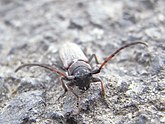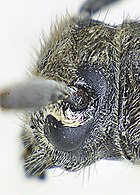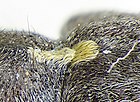Cardoria scutellata
| Cardoria scutellata | ||||||||||||
|---|---|---|---|---|---|---|---|---|---|---|---|---|

Cardoria scutellata |
||||||||||||
| Systematics | ||||||||||||
|
||||||||||||
| Scientific name | ||||||||||||
| Cardoria scutellata | ||||||||||||
| ( Fabricius , 1792) |
Cardoria scutellata ( synonym : Phytoecia scutellata ) is a beetle from the family of the longhorn beetle and the subfamily of Weber bucks .
Notes on the name and taxonomy
The species was first described by Fabricius in 1781 as Leptura scutellata . The species is described under No. 10 as Leptura nigra, scutello alba ( Latin black Leptura, white label). This explains the species name scutellata . It refers to the striking white-colored tag (scutellum) at the base of the wing covers (Fig. 6).
In 1792 Fabricius classifies the species as Saperda scutellata in the genus Saperda . In the following, different authors place the species in the genus Phytoecia . Also Mulsant leads the way in 1862 in the genus Phytoecia , but separates them at the same time. The type scutellata defines the new genus Cardoria (by generic name ( just give a wiki. Καρδία cardiac heart because of the pronotum is expanded before the middle, narrowed sharply at the bottom)). Kraatz confirms the status of Cardoria as a genus.
The genus Cardoria only contains the species Cardoria scutellata .
Characteristics of the beetle
The barrel-shaped body, especially in the female, is black and hairy white-gray. It reaches a length of 7 to 14 millimeters. The pronotum, the wing covers, legs and antennae can also be partially or completely reddish brown.
The head is inclined downwards perpendicular to the body axis. The mandibles end with only one tooth. The compound eyes are deeply edged by the antenna base, but not divided into two parts (Fig. 5). The eleven-link thread-shaped antennae are very robust and do not reach the end of the body. The first sensor element has a raised longitudinal edge on the outside (Fig. 4 and Fig. 2).
The usually black pronotum is occasionally red-brown above. A small spot in front of the label is like the label itself with thick white hairs (Fig. 6).
The narrow elytra are uniformly tomentosed . They taper significantly towards the rear in the male, but hardly in the female.
The abdomen is relatively short, shorter than the rest of the body when viewed from below (Fig. 3). The legs are short and sturdy. The five-limbed tarsi appear four-limbed (pseudotetrameric), since the fourth limb is very small and hidden between the lobes of the third limb. The first link of the hind tarsi is shorter than the two following combined.
 Fig. 1: Side view Fig. 2: Front view Fig. 3: Bottom   |
 Fig. 4: 1st antenna element Fig. 5: Eye Fig. 6: Small label (right)   |
biology
The warmth-loving species can be found on grass and herbs, often on the spring Adonis and Reseda species, and occasionally under stones. Sunny forest meadows, steppe heath and south-facing unwooded slopes are preferred.
The larva develops in open grassed terrain. It takes a year to develop. The common sickle carrot is specified as the host plant . The adult beetle appears in Central Europe from April to June.
distribution
The distribution area stretches from Austria , through Hungary , Slovakia , the Czech Republic , Romania to Asia Minor , on the Caucasus to Armenia .
literature
- H. Joy, KW Harde, GA Lohse: Die Käfer Mitteleuropas , Vol. 9. Spectrum Academic Publishing House in Elsevier, Munich 1966, ISBN 3-827-40683-8
- Adolf Horion: Faunistics of the Central European Beetles, Bd. XII . Überlingen-Bodensee 1974
- Klaus Koch : The Beetles of Central Europe . Ed .: Heinz Freude . tape 3 : ecology . Goecke & Evers, Krefeld 1992, ISBN 3-87263-042-3 .
Individual evidence
- ↑ a b Cardoria scutellata in Fauna Europaea. Retrieved December 20, 2010
- ↑ JCFabricius: Species insectorvm exhibentes eorvm differentias specificas, synonyma avctorvm, loca natalia, metamorphosin adiectis observationibvs, descriptionibvs, Bd.I Hamburg, Kiel 1781 first description p. 247, no. 10
- ↑ J.Christ. Fabricius: Entomologia systematica emendata et aucta. Secundum classes, ordines, genera, species adjectis synonimis, locis, observationibus, descriptionibus Tom. I pars 2 the Hague 1792 copy description of Saperda scutellata p. 317
- ^ ME Mulsant: Histoire naturelle des coléoptères de France Paris 1862–1863 Cardoria p.436
- ↑ Sigmund Schenkling: Explanation of the scientific beetle names (genus)
- ↑ G. Kraatz: About German Phytoecia species German entomological journal / Entomologische Nachrichten 20th year 1876 p. 380 sub-genera of Phytoecia
- ↑ Cardoria at Fauna Europaea. Retrieved February 19, 2013
- ↑ Cardoria at BioLib
- ↑ Cerambycidae of the West Palaearctic region